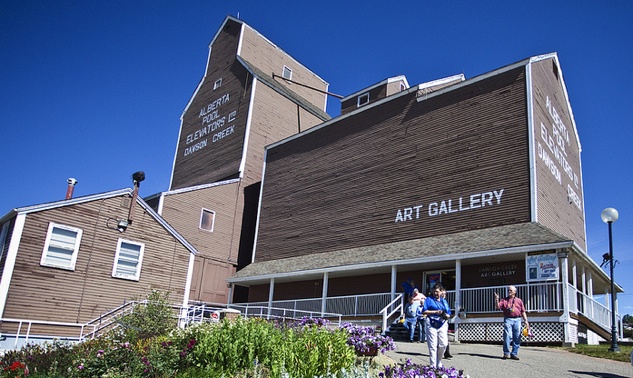Dawson Creek’s thriving arts scene leads to the unexpected
Dawson Creek, which marks the start of the Alaska Highway, has a thriving arts scene that begins at the local art gallery and leads to the unexpected

Experience the arts scene
An old Alberta Wheat Pool grain elevator has been converted into the Dawson Creek Art Gallery and features paintings and mixed-media art from the Peace Region and across Canada. The elevator is celebrating the 30th anniversary of its conversion this year—an amazing feat, having been moved to this location at that time. The gallery was awarded the Heritage of Canada Foundation Award of Merit in 1984 and features a unique design trademarked by ramps along its four walls, each of which spirals up to the art displays.
And if art is your interest, self-guided tours of downtown Dawson Creek take you on a voyage through the town’s history via a series of large murals depicting historical events and the evolution of some of Dawson Creek’s buildings.
Wildlife with a twist
Located next door to the Dawson Creek Art Gallery is the original railway station, constructed in 1931 for the Northern Alberta Railway. The building now houses the Dawson Creek Station Museum, which showcases the cultural and industrial history of Dawson Creek, as well as an impressive collection of taxidermy.
“People come out this way thinking they’ll see a lot of wildlife,” said Sally Gibreault, tourism development co-ordinator for Tourism Dawson Creek, “but if they don’t see what they’re looking for along the highway, here’s their chance.”
While the first part of the Dawson Creek Station Museum presents artifacts mainly focused on the railway’s history and its contribution to the town’s development, the second part displays fossils, moose, bears and a vast array of native bird species.
Kiskatinaw Bridge
If construction is an art, the Kiskatinaw Bridge is the Mona Lisa of timber-truss structures. In the early 1940s, the U.S. Army Corps of Engineers met the challenge of fording rivers and creeks to expedite military traffic between Dawson Creek and Big Delta, Alaska, with this (and other) timber-truss bridges—but the Kiskatinaw is the only one still in use in the region.
Curving nine degrees along its 534-foot length, the bridge was the first of its kind and one of the most unusual in shape. About 500,000 board feet of creosoted B.C. fir was used to construct the three-span bridge, 100 feet above a stream. It is held up with pedestals and piers comprised of 800 cubic yards of concrete that, during construction, had to be enclosed and heated to 22 degrees Celcius for 10 days thanks to an extreme cold snap.
These days the bridge is part of Kiskatinaw Provincial Park and an excellent place to explore another part of Dawson Creek’s history.
The Hart Hotel and Pub
For something truly out of the ordinary, take a drive 10 minutes south of Dawson Creek to Pouce Coupe, a historically rich community of 833 people with a watering hole that’s definitely worth the drive.
Watch for The Hart Hotel, constructed in 1928 and currently featuring a seven-room accommodation and an excellent restaurant. But the interesting draw, said Gibeault, is the pub, which offers a unique display of life-sized chainsaw carvings of patrons who have passed on.
“It’s the most unique thing you’ve ever seen,” she said. “They are quite artistic too.”






